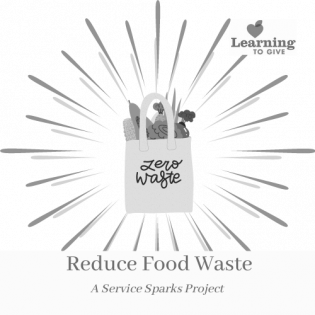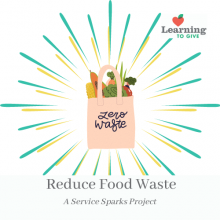Service Sparks: Reduce Food Waste
Keywords:
Community
Community Service Project
farming
Food Insecurity
Food Waste
SimpleSafeService
Ignite meaningful action that lights up the world through "Service Sparks" youth projects! Learn about the ways food is wasted in homes, restaurants, farms, stores, and other places. Examine the habits in the community or in your house and propose ways to reduce food waste. Make the next right choice to improve the availability of food to people who are hungry.
SERVICE SPARKS
Ignite meaningful action that lights up the world through "Service Sparks" youth projects!
One-third of the world's food is wasted. People buy too much and throw away rotten food. Stores and restaurants can't serve vegetables that aren't attractive. Farms dump food when they produce too much. With all that waste in the world, there is an opportunity to make changes to be sure all the people suffering from hunger get the food they need.
- Read about ways food is wasted in the world. Google these keywords to learn more: USDA + food waste. Interview a food pantry in your community (or a restaurant) to learn where there is waste and what can be done.
- Discuss how it feels that so much food is wasted when so many people aren't getting enough to eat.
- Brainstorm ideas to make a difference. Posters and social media may make people aware of places where excess food can be safely shared. Families may deliver leftover event food to a pantry or give cooking lessons for creative leftovers.
- Talk with your family about what you and your family can do to reduce food waste. Some ideas: Eat leftovers instead of making something new, buy less food at the store, take only the portions you can eat and eat what you take, and eat out less often. Your family can also compost food waste instead of sending it to a landfill.
- Make a plan and write a pledge of something you agree to do to change your actions. You may also kindly share what you learned on social media or on posters. Can you teach other people to waste less?
- Challenge: Monitor your family's food purchasing and waste for two weeks. Put together a small presentation about observations and suggest changes to food buying and eating habits to reduce waste.
- BONUS: Chart the items purchased and then tally when items are used for a meal. At the end of the week, note what items did you use and what items are going to waste. Charts are a helpful visual learning tool.
- Connect with a local community garden or food program with this Learning to Give guide.
Reflection: You are one person and your family is one household. Write a plan in which one small action influences a bigger impact.
Explore more Service Sparks projects:
Learning to Give ...
- educates youth about philanthropy, the civil society sector, and the importance of giving their time, talent and treasure for the common good (knowledge),
- equips youth by encouraging philanthropic behavior and experience (skills), and,
- empowers youth to take voluntary citizen action for the common good in their classrooms, lives and communities (behavior).

